Daniel Muthukrishna
Transfer Learning for Transient Classification: From Simulations to Real Data and ZTF to LSST
Feb 25, 2025Abstract:Machine learning has become essential for automated classification of astronomical transients, but current approaches face significant limitations: classifiers trained on simulations struggle with real data, models developed for one survey cannot be easily applied to another, and new surveys require prohibitively large amounts of labelled training data. These challenges are particularly pressing as we approach the era of the Vera Rubin Observatory's Legacy Survey of Space and Time (LSST), where existing classification models will need to be retrained using LSST observations. We demonstrate that transfer learning can overcome these challenges by repurposing existing models trained on either simulations or data from other surveys. Starting with a model trained on simulated Zwicky Transient Facility (ZTF) light curves, we show that transfer learning reduces the amount of labelled real ZTF transients needed by 75\% while maintaining equivalent performance to models trained from scratch. Similarly, when adapting ZTF models for LSST simulations, transfer learning achieves 95\% of the baseline performance while requiring only 30\% of the training data. These findings have significant implications for the early operations of LSST, suggesting that reliable automated classification will be possible soon after the survey begins, rather than waiting months or years to accumulate sufficient training data.
A Classifier-Based Approach to Multi-Class Anomaly Detection for Astronomical Transients
Mar 21, 2024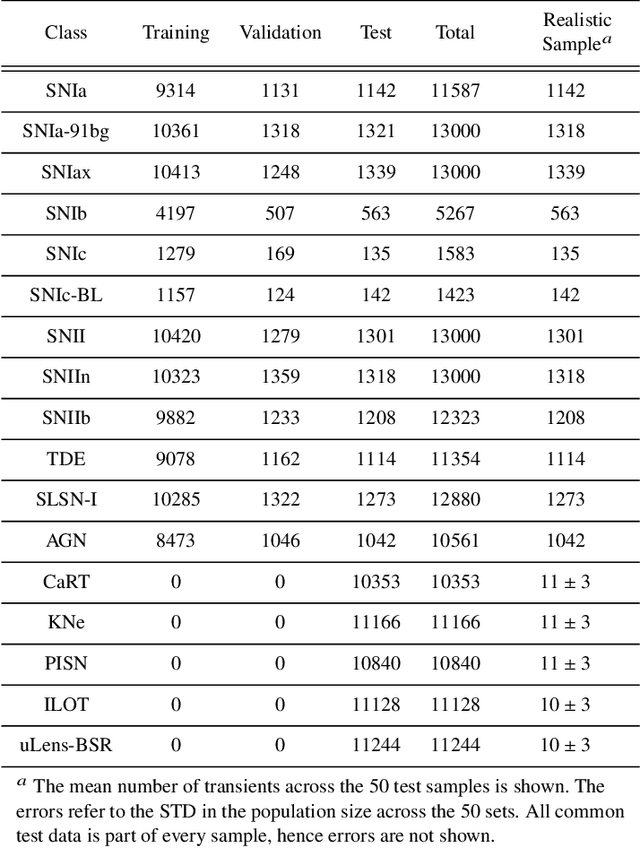
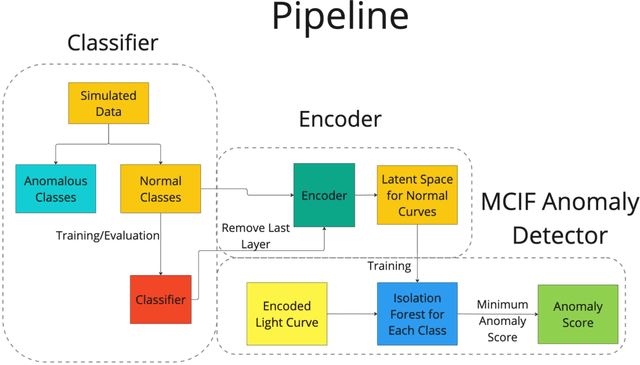
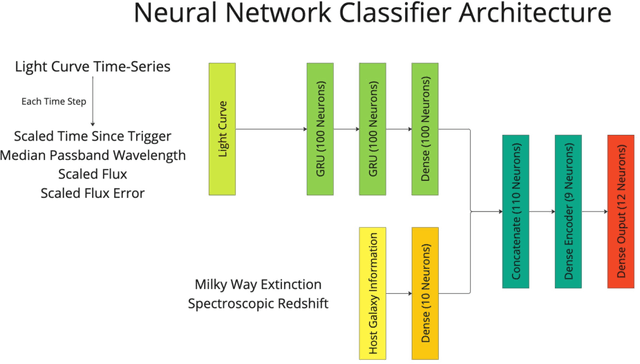
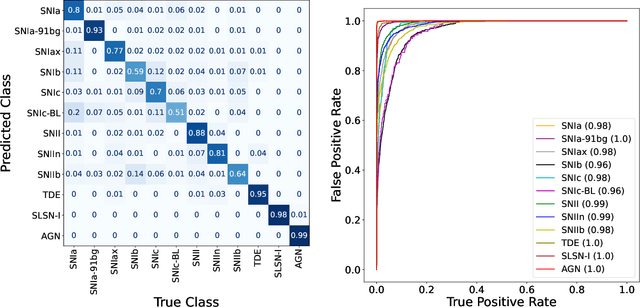
Abstract:Automating real-time anomaly detection is essential for identifying rare transients in the era of large-scale astronomical surveys. Modern survey telescopes are generating tens of thousands of alerts per night, and future telescopes, such as the Vera C. Rubin Observatory, are projected to increase this number dramatically. Currently, most anomaly detection algorithms for astronomical transients rely either on hand-crafted features extracted from light curves or on features generated through unsupervised representation learning, which are then coupled with standard machine learning anomaly detection algorithms. In this work, we introduce an alternative approach to detecting anomalies: using the penultimate layer of a neural network classifier as the latent space for anomaly detection. We then propose a novel method, named Multi-Class Isolation Forests (MCIF), which trains separate isolation forests for each class to derive an anomaly score for a light curve from the latent space representation given by the classifier. This approach significantly outperforms a standard isolation forest. We also use a simpler input method for real-time transient classifiers which circumvents the need for interpolation in light curves and helps the neural network model inter-passband relationships and handle irregular sampling. Our anomaly detection pipeline identifies rare classes including kilonovae, pair-instability supernovae, and intermediate luminosity transients shortly after trigger on simulated Zwicky Transient Facility light curves. Using a sample of our simulations that matched the population of anomalies expected in nature (54 anomalies and 12,040 common transients), our method was able to discover $41\pm3$ anomalies (~75% recall) after following up the top 2000 (~15%) ranked transients. Our novel method shows that classifiers can be effectively repurposed for real-time anomaly detection.
Predicting the Age of Astronomical Transients from Real-Time Multivariate Time Series
Nov 28, 2023Abstract:Astronomical transients, such as supernovae and other rare stellar explosions, have been instrumental in some of the most significant discoveries in astronomy. New astronomical sky surveys will soon record unprecedented numbers of transients as sparsely and irregularly sampled multivariate time series. To improve our understanding of the physical mechanisms of transients and their progenitor systems, early-time measurements are necessary. Prioritizing the follow-up of transients based on their age along with their class is crucial for new surveys. To meet this demand, we present the first method of predicting the age of transients in real-time from multi-wavelength time-series observations. We build a Bayesian probabilistic recurrent neural network. Our method can accurately predict the age of a transient with robust uncertainties as soon as it is initially triggered by a survey telescope. This work will be essential for the advancement of our understanding of the numerous young transients being detected by ongoing and upcoming astronomical surveys.
Identifying Exoplanets with Deep Learning. V. Improved Light Curve Classification for TESS Full Frame Image Observations
Jan 03, 2023Abstract:The TESS mission produces a large amount of time series data, only a small fraction of which contain detectable exoplanetary transit signals. Deep learning techniques such as neural networks have proved effective at differentiating promising astrophysical eclipsing candidates from other phenomena such as stellar variability and systematic instrumental effects in an efficient, unbiased and sustainable manner. This paper presents a high quality dataset containing light curves from the Primary Mission and 1st Extended Mission full frame images and periodic signals detected via Box Least Squares (Kov\'acs et al. 2002; Hartman 2012). The dataset was curated using a thorough manual review process then used to train a neural network called Astronet-Triage-v2. On our test set, for transiting/eclipsing events we achieve a 99.6% recall (true positives over all data with positive labels) at a precision of 75.7% (true positives over all predicted positives). Since 90% of our training data is from the Primary Mission, we also test our ability to generalize on held-out 1st Extended Mission data. Here, we find an area under the precision-recall curve of 0.965, a 4% improvement over Astronet-Triage (Yu et al. 2019). On the TESS Object of Interest (TOI) Catalog through April 2022, a shortlist of planets and planet candidates, Astronet-Triage-v2 is able to recover 3577 out of 4140 TOIs, while Astronet-Triage only recovers 3349 targets at an equal level of precision. In other words, upgrading to Astronet-Triage-v2 helps save at least 200 planet candidates from being lost. The new model is currently used for planet candidate triage in the Quick-Look Pipeline (Huang et al. 2020a,b; Kunimoto et al. 2021).
Real-time Detection of Anomalies in Multivariate Time Series of Astronomical Data
Dec 15, 2021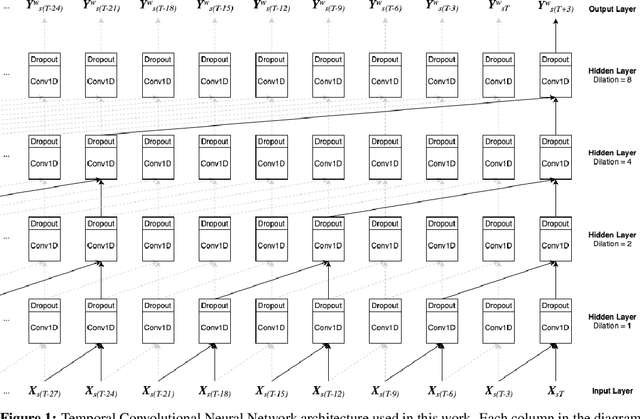


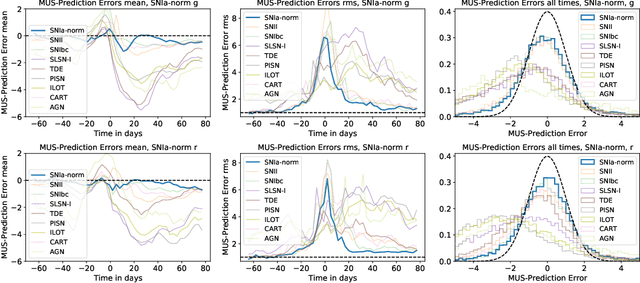
Abstract:Astronomical transients are stellar objects that become temporarily brighter on various timescales and have led to some of the most significant discoveries in cosmology and astronomy. Some of these transients are the explosive deaths of stars known as supernovae while others are rare, exotic, or entirely new kinds of exciting stellar explosions. New astronomical sky surveys are observing unprecedented numbers of multi-wavelength transients, making standard approaches of visually identifying new and interesting transients infeasible. To meet this demand, we present two novel methods that aim to quickly and automatically detect anomalous transient light curves in real-time. Both methods are based on the simple idea that if the light curves from a known population of transients can be accurately modelled, any deviations from model predictions are likely anomalies. The first approach is a probabilistic neural network built using Temporal Convolutional Networks (TCNs) and the second is an interpretable Bayesian parametric model of a transient. We show that the flexibility of neural networks, the attribute that makes them such a powerful tool for many regression tasks, is what makes them less suitable for anomaly detection when compared with our parametric model.
Real-time detection of anomalies in large-scale transient surveys
Oct 29, 2021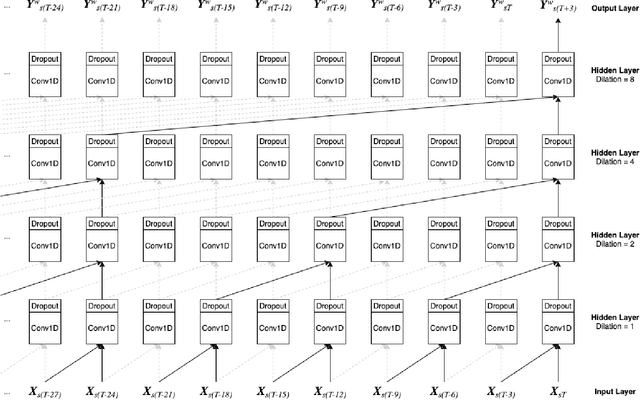

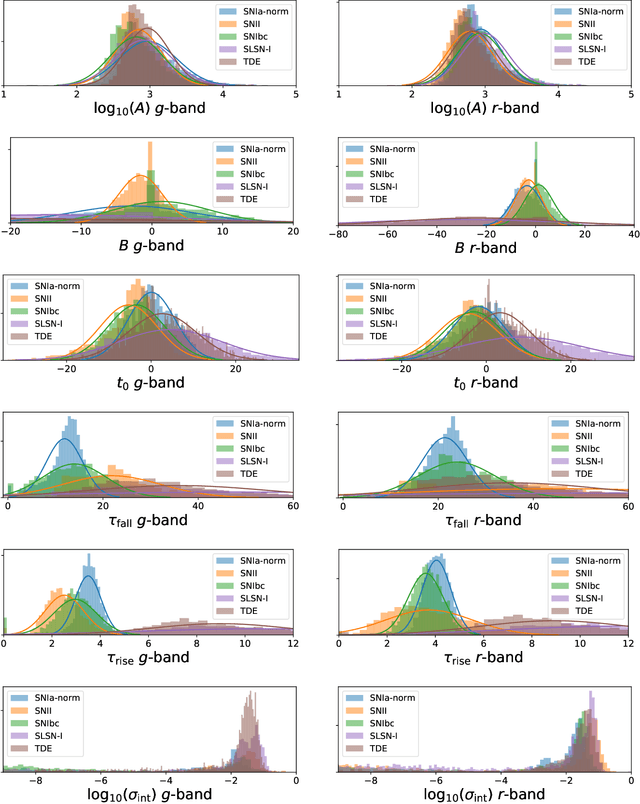
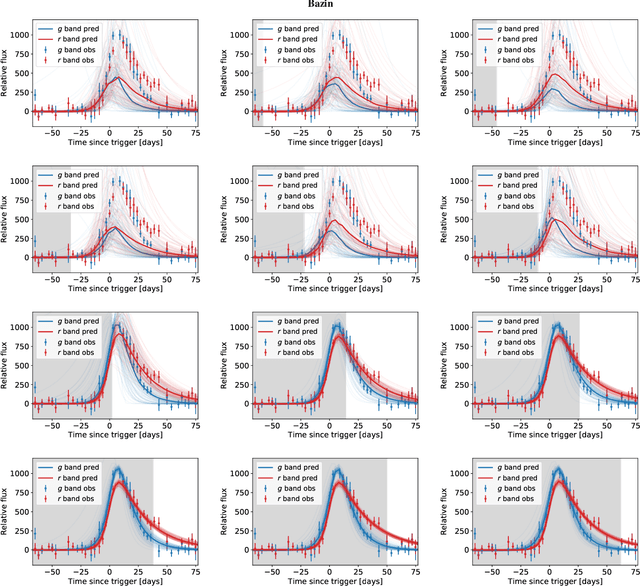
Abstract:New time-domain surveys, such as the Rubin Observatory Legacy Survey of Space and Time (LSST), will observe millions of transient alerts each night, making standard approaches of visually identifying new and interesting transients infeasible. We present two novel methods of automatically detecting anomalous transient light curves in real-time. Both methods are based on the simple idea that if the light curves from a known population of transients can be accurately modelled, any deviations from model predictions are likely anomalies. The first modelling approach is a probabilistic neural network built using Temporal Convolutional Networks (TCNs) and the second is an interpretable Bayesian parametric model of a transient. We demonstrate our methods' ability to provide anomaly scores as a function of time on light curves from the Zwicky Transient Facility. We show that the flexibility of neural networks, the attribute that makes them such a powerful tool for many regression tasks, is what makes them less suitable for anomaly detection when compared with our parametric model. The parametric model is able to identify anomalies with respect to common supernova classes with low false anomaly rates and high true anomaly rates achieving Area Under the Receive Operating Characteristic (ROC) Curve (AUC) scores above 0.8 for most rare classes such as kilonovae, tidal disruption events, intermediate luminosity transients, and pair-instability supernovae. Our ability to identify anomalies improves over the lifetime of the light curves. Our framework, used in conjunction with transient classifiers, will enable fast and prioritised follow-up of unusual transients from new large-scale surveys.
RAPID: Early Classification of Explosive Transients using Deep Learning
Mar 29, 2019
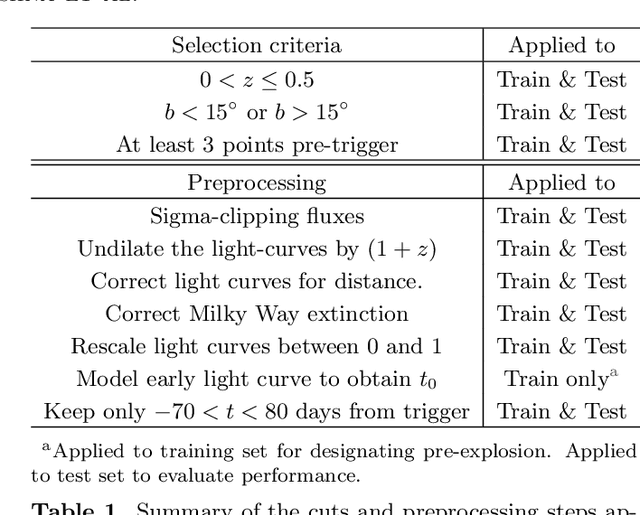
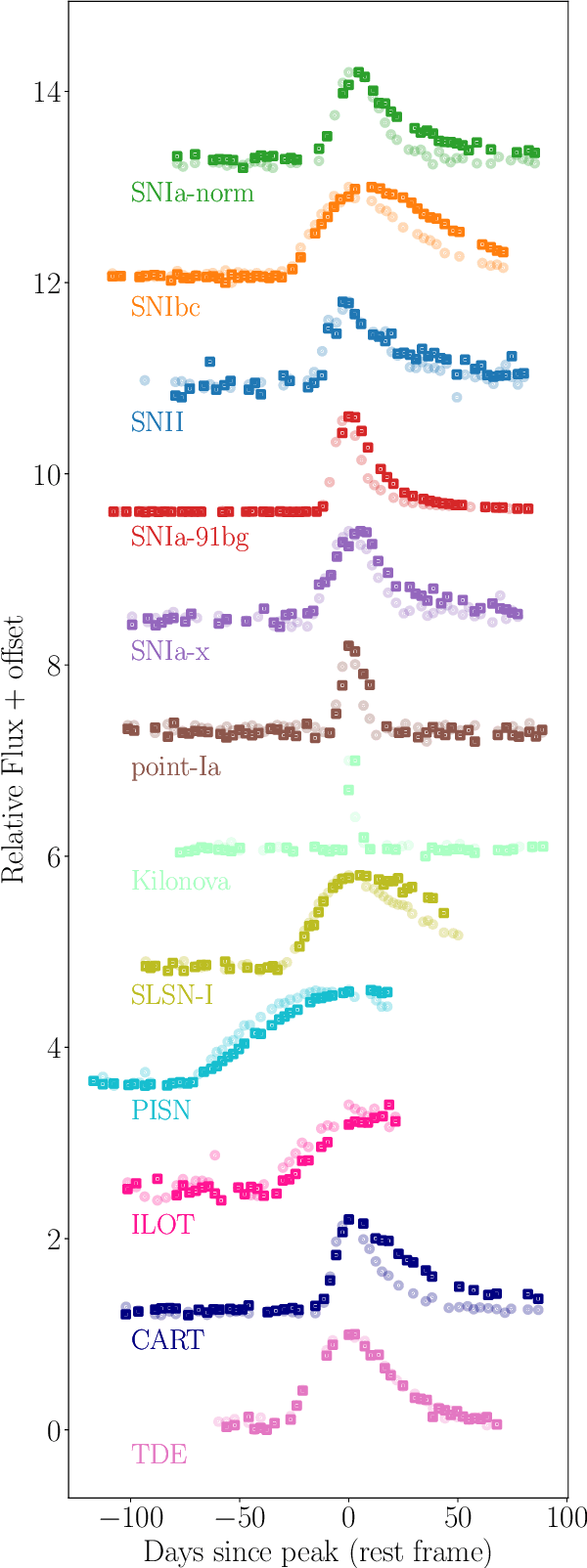
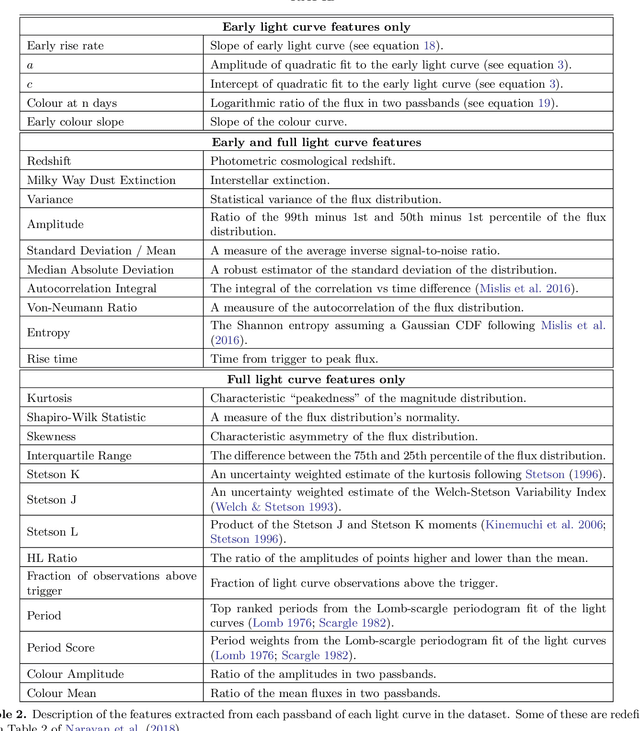
Abstract:We present RAPID (Real-time Automated Photometric IDentification), a novel time-series classification tool capable of automatically identifying transients from within a day of the initial alert, to the full lifetime of a light curve. Using a deep recurrent neural network with Gated Recurrent Units (GRUs), we present the first method specifically designed to provide early classifications of astronomical time-series data, typing 12 different transient classes. Our classifier can process light curves with any phase coverage, and it does not rely on deriving computationally expensive features from the data, making RAPID well-suited for processing the millions of alerts that ongoing and upcoming wide-field surveys such as the Zwicky Transient Facility (ZTF), and the Large Synoptic Survey Telescope (LSST) will produce. The classification accuracy improves over the lifetime of the transient as more photometric data becomes available, and across the 12 transient classes, we obtain an average area under the receiver operating characteristic curve of 0.95 and 0.98 at early and late epochs, respectively. We demonstrate RAPID's ability to effectively provide early classifications of transients from the ZTF data stream. We have made RAPID available as an open-source software package (https://astrorapid.readthedocs.io) for machine learning-based alert-brokers to use for the autonomous and quick classification of several thousand light curves within a few seconds.
 Add to Chrome
Add to Chrome Add to Firefox
Add to Firefox Add to Edge
Add to Edge